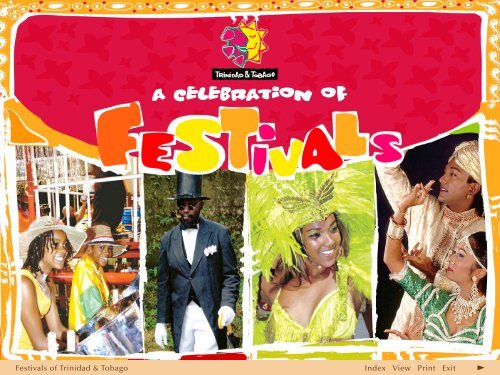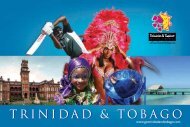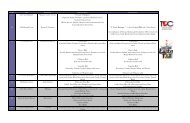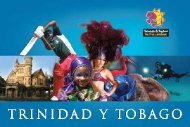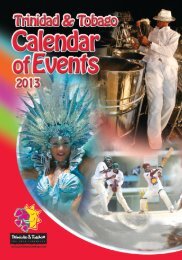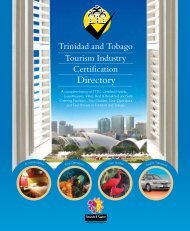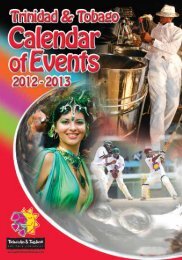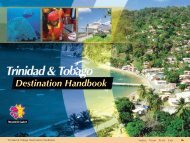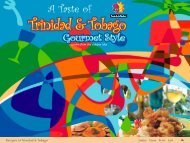Trinidad & Tobago - A Celebration of Festivals - Trinidad and Tobago
Trinidad & Tobago - A Celebration of Festivals - Trinidad and Tobago
Trinidad & Tobago - A Celebration of Festivals - Trinidad and Tobago
You also want an ePaper? Increase the reach of your titles
YUMPU automatically turns print PDFs into web optimized ePapers that Google loves.
a celebration <strong>of</strong><strong>Festivals</strong> <strong>of</strong> <strong>Trinidad</strong> & <strong>Tobago</strong> Index View Print Exit /
Carnival<strong>Festivals</strong> <strong>of</strong> <strong>Trinidad</strong> & <strong>Tobago</strong>\ Index View Print Exit /
CarnivalT h e G r e at e s t S h o w on E a rt hFebruary / MarchThe Carnival is not just one festival, but aseries s<strong>and</strong>wiched in between Christmas<strong>and</strong> Ash Wednesday. And because AshWednesday is fixed 40 days before themoveable feast <strong>of</strong> Easter, the season maybe long or short -generally six to tenweeks - in which to pack the play-<strong>of</strong>fs <strong>of</strong>the premier Pan (steelb<strong>and</strong>), Calypso <strong>and</strong>Mas’ competitions in the world.<strong>Trinidad</strong> & <strong>Tobago</strong> created these uniqueart forms out <strong>of</strong> the confluence <strong>of</strong>cultures - European, African, Indian,Asian - assembled here in the centuriessince Columbus. The songs <strong>of</strong> the slaves<strong>and</strong> their oral news network are nowpithy calypsos <strong>of</strong> social commentary <strong>and</strong>fast-paced rhythmic soca, the music <strong>and</strong>poetry <strong>of</strong> the festival.The masked balls <strong>of</strong> the European mastershave exploded onto the streets, withcostume <strong>and</strong> mime - look for devils,demons, midnight robbers, bats <strong>and</strong> mokojumbies - <strong>and</strong> dancing parties, thous<strong>and</strong>sstrong, revelling in liberatingly loud music<strong>and</strong> licence to cavort in the heart <strong>of</strong>Port <strong>of</strong> Spain’s business district! It is thistransformation wrought by costume <strong>and</strong>music that has been called simply Mas’,<strong>and</strong> used to refer to children, adults,individually or in b<strong>and</strong>s, costumed forstreet or stage parades.It was also out <strong>of</strong> attempts to suppressthe drum that the steelb<strong>and</strong> eventuallyemerged. Now simply called pan, it is theonly musical instrument invented in thelast century.The season’s schedule starts with theopening <strong>of</strong> the calypso tents. Calypsoniansin T&T will present the songs that willmove from <strong>Trinidad</strong> to all the othercarnivals for the year. This is where thehits are made. This is where musiciansfrom other isl<strong>and</strong>s <strong>and</strong> territories comefor approval. Listen for the panyardpractices late into the night as Panorama,the steelb<strong>and</strong> competitions, draw near.And visit the mas camps where thecostumes for the big b<strong>and</strong>s are alreadybeing distributed.Where <strong>and</strong> when:The vast influx <strong>of</strong> visitors <strong>and</strong> returningresidents is usually concentrated in theweek before the Carnival. Fetes, pan,calyspo <strong>and</strong> mas’ events are planned intowns <strong>and</strong> villages all over the two isl<strong>and</strong>s,but mainly in <strong>and</strong> around Port <strong>of</strong> Spain.Most visitors stay until the weekend afterCarnival, taking in <strong>Tobago</strong>, sea baths <strong>and</strong>post-Carnival shows.<strong>Festivals</strong> <strong>of</strong> <strong>Trinidad</strong> & <strong>Tobago</strong>\ Index View Print Exit /
Phagwa<strong>Festivals</strong> <strong>of</strong> <strong>Trinidad</strong> & <strong>Tobago</strong>\ Index View Print Exit /
PhagwaA C e l e br at i on <strong>of</strong> G o od o v e r E v i lDetermined by the Lunar CalendarAlso known as Holi, Phagwa celebratesPrahlaad, a child-prince who waspersecuted by his emperor father forrefusing to worship him as God.He ordered his sister Holika, to destroythe prince by fire; but he was miraculouslysaved while Holika perished.Phagwa season begins with the planting <strong>of</strong>a castor oil plant symbolizing Holika. In thefollowing five to six weeks, the communityputs rubbish around the tree. During thistime, villagers gather at different homesto sing chowataal or folksongs. Singersaccompany themselves on jhaals - smallbrass cymbals - <strong>and</strong> are led by drummers.Above the loud rhythms, strong voicesmust rise in ever-increasing speed to chantcomplex tongue twisters in Bhojpuri, adialect <strong>of</strong> North India.The re-enactment <strong>of</strong> Prahlaad’s escapeis held on the eve <strong>of</strong> Phagwa - fullmoon night. The large pyre is set fireafter a ceremony. As the fire subsides,participants throw ashes on each other.At dawn, neighbours vie to be the firstto douse abeer - magenta colouredwater - on each other, then take to thestreets singing, dancing <strong>and</strong> holding mockbattles. Every one is liable to be sprayedwith large syringe-like instruments calledpichakaarees.Where <strong>and</strong> When:Venues include Children’s Phagwa atTunapuna Hindu School. Adult chowtaalb<strong>and</strong>s compete at Aranguez, Tunapuna,Carlsen Field <strong>and</strong> other venues.A competition hosted by the Kendra atDivali Nagar, provides stinging bilingualsocial commentaries called pichakaarees.You will also view Makhan Chor, a contestin which groups <strong>of</strong> youths form humanpyramids to reach a pot <strong>of</strong> dahee - curds- at the top <strong>of</strong> a tall tower. It is advisableto walk with a towel, <strong>and</strong> cover car seatswith plastic.<strong>Festivals</strong> <strong>of</strong> <strong>Trinidad</strong> & <strong>Tobago</strong>\ Index View Print Exit /
Buccoogoat racefestival<strong>Festivals</strong> <strong>of</strong> <strong>Trinidad</strong> & <strong>Tobago</strong>\ Index View Print Exit /
Buccoo goat race festivalTob a g o ’s G r a n d E a s t e r R a c e M e e t i n gAprilIf the run-up to the austere RomanCatholic Lenten season is Carnival in<strong>Trinidad</strong>, then it is appropriate that thecelebratory end <strong>of</strong> self-denial takes placein <strong>Tobago</strong>, where <strong>Trinidad</strong>ians flock onthe longest weekend <strong>of</strong> the year (GoodFriday, Glorious Saturday, Easter Sunday<strong>and</strong> Easter Monday) for sun, sea-bathing,<strong>and</strong> the odd <strong>and</strong> enjoyable goat <strong>and</strong> crabraces.There may be no corbeaux (blackvultures) on <strong>Tobago</strong>, but there are plenty<strong>of</strong> blue backed crabs. And here you’reallowed to play with your food beforeyou eat it. In some races, the crabs areencouaged to run on a straight course -have you ever seen a crab run?Otherwise, all the crab competitors areplaced in the centre <strong>of</strong> a large circle drawnin the s<strong>and</strong>, <strong>and</strong> the first one to get out <strong>of</strong>the circle is declared the winner.Owners run around, scream, cajole <strong>and</strong>entice the side-stepping crustaceans, butin the end, it’s the owner that takes theprize, <strong>and</strong> all competitors go into thepot. Curried crab <strong>and</strong> dumpling is just asdelicious whether your crab has raced <strong>and</strong>won, or not.Wacky companion event to the crabraces are the goat races. These takeconsiderably more preparation since goatsare usually trained for months beforeon whatever beach or pasture might benearby. Their jockeys run either beside orbehind, holding on to or being dragged bytheir steeds. Spectators place their bets,<strong>and</strong> are allowed to scream their lungs outfor Betty, Neddy, Goatee...So Engl<strong>and</strong> has Astor, we have Buccoo.The races take place in the sun, so bars,buffets <strong>and</strong> ice cream vendors do athriving trade.Where <strong>and</strong> when:Easter sports take place at communitygrounds over the Easter weekend. Mainvenue for the Goat <strong>and</strong> Crab Races isBuccoo on Easter Tuesday.<strong>Festivals</strong> <strong>of</strong> <strong>Trinidad</strong> & <strong>Tobago</strong>\ Index View Print Exit /
RAPSOFEST<strong>Festivals</strong> <strong>of</strong> <strong>Trinidad</strong> & <strong>Tobago</strong>\ Index View Print Exit /
RAPSOFESTT h e P o w e r <strong>of</strong> t h e Or a l T r a d i t i on sApril / May11Rapso is “the power <strong>of</strong> the word in therhythm <strong>of</strong> the word”. It is a unique style <strong>of</strong>street poetry that emerged in <strong>Trinidad</strong> &<strong>Tobago</strong> during the period <strong>of</strong> the 1970s, thatcame to be known as the Black Power era.It is a natural progression in <strong>Trinidad</strong> fromthe traditions <strong>of</strong> the African Griot thatflowed through the Chantwell to Calypso,Pierrot Grenade <strong>and</strong> Midnight Robber.Lancelot Layne created the first Rapsorecordings with his conscious lyrics, BlowAway <strong>and</strong> Get <strong>of</strong>f the Radio, in the early1970s. Cheryl Byron was the first to takeRapso to the Calypso tent, in 1976, <strong>and</strong> isrecognised as the “mother <strong>of</strong> Rapso.”The conscious effort to popularise Rapsoas a community festival began with the firstRaps<strong>of</strong>est in 1991. It takes place duringApril <strong>and</strong> May. Month long <strong>of</strong> workshopsaddress the need to orient young peopleto the art form which is “world music <strong>and</strong>poetry” according to Brother Resistance,indefatigable advocate <strong>of</strong> Rapso.Workshops take place throughout <strong>Trinidad</strong>& <strong>Tobago</strong> <strong>and</strong> have the support <strong>of</strong> theNational Library system, with schools<strong>and</strong> community centres as venues. Thesesessions culminate in the first <strong>of</strong> fourperformance events in May.Breaking New Ground allows the recentinitiates <strong>of</strong> Rapso to present new works tothe public. Children’s Story Time introducesthe art in a familiar form, to children bychildren. Women <strong>of</strong> the Oral Tradition intribute to Cheryl Byron, features strongvoices like Sista Ava, Samantha Pierre,Shakilah <strong>and</strong> Eintou Pearl Springer.The big climax, Rapso Night Concert,brings artistes from all over the Caribbean:Adissa from Barbados; Ras Mo fromDominica; Ras I from St Lucia; Muta Barukafrom Jamaica; Papa Loko from Haiti. In T&T,Brother Resistance <strong>and</strong> Karega M<strong>and</strong>elawith the Network Riddum B<strong>and</strong> have longcarried the torch for Rapso, <strong>and</strong> are happyto have such good company as 3 Canal,Ataklan, Kindred, Blak Lyrics, Ozzie Magic,Andre Tanker, SuperBlue, Black Stalin <strong>and</strong>David Rudder.Where <strong>and</strong> when:The amphitheatre <strong>of</strong> the National Libraryin Port <strong>of</strong> Spain <strong>and</strong> Little Carib theatre aremain venues. All workshops <strong>and</strong> seminarstake place in April; performances in May.For more information, visit websites,www.visittnt.com, www.raps<strong>of</strong>est.com,www.brotherresistance.com or contactBrother Resistance (telephone 868-620-2966; 868-622-4161)<strong>Festivals</strong> <strong>of</strong> <strong>Trinidad</strong> & <strong>Tobago</strong>\ Index View Print Exit /
<strong>Tobago</strong>InternationalGospelfestival<strong>Festivals</strong> <strong>of</strong> <strong>Trinidad</strong> & <strong>Tobago</strong>\ Index View Print Exit /
GangaDHAARAa<strong>Festivals</strong> <strong>of</strong> <strong>Trinidad</strong> & <strong>Tobago</strong>\ Index View Print Exit /
Ganga DHAARAaA T r i b u t e t o t h e ‘ M ot h e r ’ <strong>of</strong> C i v i l i s at i onLate June15Colourful flags map out the route alonga winding mountain road. A pristine riverbecomes an altar, tall trees are the walls,<strong>and</strong> the open sky is the ro<strong>of</strong> <strong>of</strong> nature’sm<strong>and</strong>ir. Lit deeyas in prayer boats made<strong>of</strong> coconut fibre sail intermittently alongthe lazily flowing mountain river.And women wearing saris <strong>of</strong> yellowbuttercups flutter by.This is Ganga Dhaaraa (Dashara), theoldest river festival in the world. It is a<strong>Festivals</strong> <strong>of</strong> <strong>Trinidad</strong> & <strong>Tobago</strong>unique experience <strong>of</strong> man, nature <strong>and</strong>God in communion.There are seven ghaats or locations alongthe banks where over 25 activities areheld. Worship at a small cave is importantfor pilgrims. Devotees, predominantly inyellow traditional clothes, st<strong>and</strong> in thewater, or on the banks or stony hillocksbearing fruits <strong>and</strong> burning incense in brassvessels.The blasts <strong>of</strong> shankh - conch shell - bells,<strong>and</strong> voices in praise are raised, sometimesclose by, <strong>and</strong> sometimes echoing in thedistance.The festival remembers an ancientcataclysmic ecological event when asevere need for fresh water threatened todestroy human civilization. The Puraanictexts record that Bhagirathi, a descendent<strong>of</strong> Emperor Sagar’s children who wereburnt to ashes, suffered severe hardshipto bring down Ganga from the heavensto revive them. An annual award, anecological mantra, discourse <strong>and</strong> folk songsare part <strong>of</strong> the nature festival.Light, non-leather shoes are best for theoccasion. Bring along a change <strong>of</strong> clothes<strong>and</strong> towel.Where <strong>and</strong> when:The trek starts in the Blanchisseuse forestaround the 18-mile post, in the pre-dawndarkness. Led by the pundit, celebrantswalk up-river to the designated spot.Check your daily newspaper for the date,usually a Sunday in early June; TDC,or the Kendra (665-4270)\ Index View Print Exit /
<strong>Tobago</strong>Heritagefestival<strong>Festivals</strong> <strong>of</strong> <strong>Trinidad</strong> & <strong>Tobago</strong>\ Index View Print Exit /
<strong>Tobago</strong> Heritage festivalA C e l e br at i on <strong>of</strong> Tob a g o ’s D a n c e , S t ory t e l l i n g , M u s i c & F o odLate July17<strong>Tobago</strong>’s history has taken different twists<strong>and</strong> turns from <strong>Trinidad</strong>’s. It was neverseen by Columbus, but instead claimedby English adventurers for their king.They had to contend with the originalinhabitants who were by all accountsfierce defenders <strong>of</strong> their isl<strong>and</strong>, <strong>and</strong> whohad cultivated <strong>and</strong> smoked tobacco, theplant for which the isl<strong>and</strong> was named.The isl<strong>and</strong> changed h<strong>and</strong>s several timesamong European powers including theDutch, Courl<strong>and</strong>ers (a Baltic principality)<strong>and</strong> the French. A fertile salubrious isl<strong>and</strong>,<strong>Tobago</strong> was “the jewel <strong>of</strong> the Caribbean”<strong>and</strong> home to an elite planter class thatdepended on African slaves who acquiredl<strong>and</strong> after the abolition <strong>of</strong> slavery in 1834.In 1889, <strong>Tobago</strong> was joined with <strong>Trinidad</strong>as a British Crown Colony. Sincethen, the two isl<strong>and</strong>s have remainedone administrative entity, acquiringindependence as one nation in 1962.<strong>Tobago</strong> remains different from <strong>Trinidad</strong> inits thriving tourism industry, <strong>and</strong> a lifestylerooted in village life. The <strong>Tobago</strong> HeritageFestival celebrates traditions that arelargely African, <strong>and</strong> climax in a j’ouvert(pre-dawn street “jump up”) <strong>and</strong> streetparade on Emancipation Day (August 1),<strong>and</strong> a Great Fete early in August.The heritage events are hosted indifferent villages <strong>and</strong> feature danceperformances <strong>of</strong> Bele (or belair), Jig <strong>and</strong>Reel, all based on 18th <strong>and</strong> 19th centuryEuropean formal dances; the Ole time<strong>Tobago</strong> Wedding with its procession <strong>of</strong>the bride <strong>and</strong> groom, wedding guests <strong>and</strong>gifts, accompanied by the music <strong>of</strong> fiddle<strong>and</strong> tamb’rin (a circular skin drum).New generations <strong>of</strong> <strong>Tobago</strong>nians areinducted in community ways throughstory-telling, folk tales, superstitiions <strong>and</strong>morality plays. This is theatre in the rough,mainly for <strong>Tobago</strong>nians, but everyone iswelcome.Where <strong>and</strong> when:The events usually begin in early tomid July, <strong>and</strong> end in the Great Fete <strong>and</strong>Emancipation Day (August 1). All eventsare open to the public, with entrance fees.There’s food to be purchased at everyevent.<strong>Festivals</strong> <strong>of</strong> <strong>Trinidad</strong> & <strong>Tobago</strong>\ Index View Print Exit /
FESTIVALSOF PAN<strong>Festivals</strong> <strong>of</strong> <strong>Trinidad</strong> & <strong>Tobago</strong>\ Index View Print Exit /
FESTIVALS OF PANT h e N at i on a l I n s t r u m e n t on D i s p l ayThroughout the Year19Steelb<strong>and</strong>s were born in communities, <strong>and</strong>the panyards are centres for music as well ascommunity life. Competitions at Carnival havebeen organised to bring audiences to hear themusic in the panyards. Committees in manyb<strong>and</strong>s are not only staging their own panyardevents at different times <strong>of</strong> the year, but cooperatingto play in other yards. Some <strong>of</strong> thepanyard festivals that are putting pan on the mapare featured here. Panyard Sensations, nowin its fifth year <strong>of</strong> existence, is scheduled to be atwo month-long event <strong>of</strong> weekend pan concertshosted by the Tourism Development CompanyLimited in conjunction with PantrinbagoIncorporated.Carded to be featured this year are CaribDixiel<strong>and</strong> Steel Orchestra in <strong>Tobago</strong>; T&TECEastside New Dimesion in <strong>Tobago</strong>; SouthernMarines in South <strong>Trinidad</strong>; Parry’s Pan Schoolin Tacarigua; Excellent Stores Silver Stars in<strong>Festivals</strong> <strong>of</strong> <strong>Trinidad</strong> & <strong>Tobago</strong>Newtown; The Couva Joyl<strong>and</strong>ers; the Solo panKnights <strong>of</strong> Baraatria <strong>and</strong> Courts Sound Specialists<strong>of</strong> Laventille.Staging its Fourth Edition in 2006, The <strong>Trinidad</strong><strong>and</strong> <strong>Tobago</strong> Steel Pan & Jazz Festival boasts <strong>of</strong>a history <strong>of</strong> highest quality concert productionsthat have featured some <strong>of</strong> jazz-world’s livinglegends <strong>and</strong> leading exponents <strong>of</strong> the art <strong>of</strong> Steelpan playing. This year’s show promises to be <strong>of</strong>an internationally competitive caliber <strong>and</strong> willattract visitors from global markets. It showcasesthe best <strong>of</strong> Pan in a concert format alongsideother elements <strong>of</strong> the culture such as the tassadrumming, tamboo bamboo, rapso, talkcalypso,<strong>and</strong> some <strong>of</strong> <strong>Trinidad</strong> <strong>and</strong> <strong>Tobago</strong>’s best folkchoirs.Concerts have been held at Valley Harps SteelOrchestra Pan Theater (North) <strong>and</strong> at the NLCBFonclaire Steel Orchestra (South), in additionto Exodus, Neal & Massey All Stars, TCL SkiffleBunch, <strong>Tobago</strong> Our Boys, Tropical Angel Harps,RBTT Redemption Sound Setters, La HorquettaPan Groove <strong>and</strong> <strong>Trinidad</strong> Nostalgia; <strong>and</strong> featuredBrother Resistance, extempo champion BlackSage, Karega M<strong>and</strong>ela, saxophonist Jesse Ryan,Ken “Pr<strong>of</strong>essor” Philmore, Len Boogsie Sharpe<strong>and</strong> others.The Pan coalition in the West - Playboyz,Invaders, Phase II <strong>and</strong> Starlift - are alsoresponsible for a series <strong>of</strong> pan concerts that takeplace in their panyards.The Laventille Steelb<strong>and</strong> Festival, startedover five years ago, also invites pan lovers toa programme <strong>of</strong> concerts organised by theLaventille Community Committee, from the lasttwo weeks <strong>of</strong> July through the Emancipationholiday in the first week in August.The concert programme culminates in a streetparade, on the “Eastern Parkway”: fromMcAllister Street along the Eastern Main Roadto Leon Street. There is also an educationalcomponent <strong>of</strong> the Laventille festival - a two weekpan camp for nine to 17-year-olds selected fromschools in Laventille. The camps cover intensivesessions in pan playing <strong>and</strong> history, music practice<strong>and</strong> theory. They are also intended to identify<strong>and</strong> generate interest in careers in Pan; <strong>and</strong>maintain Laventille’s prominence as the placewhere the instrument was born.In the weeks before Christmas, Excellent StoresSilver Stars on Tragarete Road hosts “Parang <strong>and</strong>Steel” - concerts <strong>of</strong> traditional Christmas music- in their panyard on Tragarete Road.Where <strong>and</strong> when:Contact TDC (www.visittnt.com),Pan Trinbago (www.pantrinbago.com)or <strong>Trinidad</strong> <strong>and</strong> <strong>Tobago</strong> Steelpan <strong>and</strong> Jazz(www.trinidadtobagosteelpanjazz.com) for timelyinformation about Pan events.When in T&T, check the daily newspapers.\ Index View Print Exit /
Hoosay<strong>Festivals</strong> <strong>of</strong> <strong>Trinidad</strong> & <strong>Tobago</strong>\ Index View Print Exit /
HoosayS h i i t e M u s l i m C o m m e m or at i on <strong>of</strong> t h e M a rt y r d o m <strong>of</strong> I m a m H u s s a i na n d I m a m H a s s a n , ( t h e G r a n d s on s <strong>of</strong> M u h a m m a d ) , 6 4 0 a . d .Subject to the Islamic Lunar Calendar21Hoosay commemorates the martyrdom<strong>of</strong> Hussein - the gr<strong>and</strong>son <strong>of</strong> Muhammad,the Prophet <strong>of</strong> Islam - which occurred onthe “Day <strong>of</strong> Atonement” in the month<strong>of</strong> Muharram, the first month <strong>of</strong> theIslamic lunar calendar.After the death <strong>of</strong> Muhammed, conflictsover succession had ensued. Onegr<strong>and</strong>son, Hassan, died by poison. Hussain,his brother, was attacked in Kerbala (Iraq)<strong>and</strong> killed.The martyrdom <strong>of</strong> Hussain (Hoosay) <strong>and</strong>Hassan was observed by Shiite Muslimswho brought the customs to <strong>Trinidad</strong>when they came as indentured workersfrom India.The first Hoosay in <strong>Trinidad</strong> was heldin 1854. When the British colonialadministration put a ban on processions,a large crowd came out for Hoosay in SanFern<strong>and</strong>o, in 1884. Confrontation withthe police led to what is known as the“Hoosay Massacre.”The Shiites <strong>of</strong> St. James, the westernsuburb <strong>of</strong> Port <strong>of</strong> Spain, begin the month<strong>of</strong> Muharram with prayer <strong>and</strong> fasting asthey build tadjahs (Hussain’s tomb) <strong>of</strong>wood, bamboo, <strong>and</strong> tinsel. The 7th day<strong>of</strong> Muharram is Flag Night on which theHoosay-building families parade withflags <strong>and</strong> drums. The following night isLittle Hoosay Night when tadjahs arepulled through the streets accompaniedby drumming. The next night, Big HoosayNight, the tadjahs are brought outtogether with two half-moons, one eachfor Hussain <strong>and</strong> his brother Hassan.On the “Day <strong>of</strong> Atonement”, the mainprocession proceeds in daytime alonga route set out since St James was aplantation. The tadjahs reach Queen’sRoyal College at 3.30pm - the time <strong>of</strong>death - where the funeral prayer is read.Four days later, the tadjahs are draggedto the sea <strong>and</strong> destroyed.Where <strong>and</strong> when:Hoosay is commemorated in St. James,a suburb <strong>of</strong> Port-<strong>of</strong>-Spain that was settledby Indian indentured workers - streetnames include Lucknow, Mathura, Delhi,Calcutta, Cawnpore, Bengal - <strong>and</strong> Cedros,the southwest toe <strong>of</strong> <strong>Trinidad</strong>. ContactTDC for more detailed information.<strong>Festivals</strong> <strong>of</strong> <strong>Trinidad</strong> & <strong>Tobago</strong>\ Index View Print Exit /
SANTA ROSACARIB FESTIVAL<strong>Festivals</strong> <strong>of</strong> <strong>Trinidad</strong> & <strong>Tobago</strong>\ Index View Print Exit /
SANTA ROSA CARIB FESTIVALH o m a g e t o S a n ta R o s a D e L i m aAugust23Santa Rosa de Lima is supposed to haveappeared to a group <strong>of</strong> Carib men at atime when they were resisting conversionto Catholicism. Rosa, the priests claimed,had been born in Arima <strong>and</strong> taken byher parents to Peru where she dedicatedher life to helping the poor. She was thefirst canonized saint <strong>of</strong> the Americas, <strong>and</strong>her manifestation in <strong>Trinidad</strong> led to theconstruction <strong>of</strong> a church in 1759 dedicatedto Santa Rosa de Arima.The underground spring where shewas seen by the men still exists in theresidential area now known as SantaRosa Heights. * The community <strong>of</strong> thedescendants <strong>of</strong> indigenous Caribbean/Amerindian people became known as theSanta Rosa Caribs. As far as possible, theyhave retained traditional survival systems<strong>and</strong> practices including the cultivation<strong>of</strong> cassava, its processing methods <strong>and</strong>farming implements.Cassava, first cultivated <strong>and</strong> processedin the Americas - over 9000 years ago itis estimated - is now grown in equatorialcountries around the world, accounting fora wide range <strong>of</strong> industry <strong>and</strong> products.It is the fourth most important crop inthe world.Though they have little influence on thesocial or economic life <strong>of</strong> the isl<strong>and</strong>s,they have given us a rich legacy <strong>of</strong> placenames <strong>and</strong> words. According to JohnStollmeyer, <strong>Trinidad</strong> artist, Arima is their“place <strong>of</strong> beginnings,” <strong>and</strong> Naparima refersto the home <strong>of</strong> an ancestral hero, Haburithe canoe <strong>and</strong> paddle maker. Cumucurapo,site <strong>of</strong> the Port <strong>of</strong> Port <strong>of</strong> Spain was builtupon an Amerindian meeting place.And no <strong>Trinidad</strong>ian would be foolishenough to be in a hammock during ahurricane!The Santa Rosa Carib Festival takesplace in August - in the week leading upto Independence Day (August 31) <strong>and</strong>is intended to pay tribute to the FirstPeoples <strong>of</strong> the New World, <strong>and</strong> toexpose their culture to the nation.The ceremonies include the crowning<strong>of</strong> the Carib Queen, an elder matron <strong>of</strong>their community who performs the role<strong>of</strong> focusing their heritage <strong>and</strong> traditions;a church procession <strong>and</strong> performance<strong>of</strong> some <strong>of</strong> their traditional <strong>and</strong> ritualactivities - smoke ceremonies <strong>and</strong> prayer;as well as the opportunity to see thepreparation <strong>of</strong>, <strong>and</strong> purchase cassavabread.Where <strong>and</strong> when:The Santa Rosa church is a l<strong>and</strong>markin Arima which lies in the foothills <strong>of</strong><strong>Trinidad</strong>’s Northern Range. ContactTDC for details <strong>of</strong> the annual Santa Rosacelebrations.(* ref: Elma Reyes was a journalist wholived in Arima <strong>and</strong> recorded the history<strong>and</strong> customs <strong>of</strong> the Santa Rosa Caribs.)<strong>Festivals</strong> <strong>of</strong> <strong>Trinidad</strong> & <strong>Tobago</strong>\ Index View Print Exit /
EMANCIPATION<strong>Festivals</strong> <strong>of</strong> <strong>Trinidad</strong> & <strong>Tobago</strong>\ Index View Print Exit /
EMANCIPATIONA C e l e br at i on <strong>of</strong> F r e e d o mAugust 1st25On August 1, 1838, the enslaved Africansthroughout the British Empire in theCaribbean were finally freed from thebondage <strong>of</strong> chattel slavery.In 1985, August 1, Emancipation Day,was declared a national holiday. Since1985, Emancipation celebrations havegrown into a major national festival,where tens <strong>of</strong> thous<strong>and</strong>s <strong>of</strong> peopleparticipate in various activities.The Emancipation Support Committee<strong>of</strong> <strong>Trinidad</strong> & <strong>Tobago</strong> hosts a week <strong>of</strong>activities leading up to Emancipation Dayincluding cultural performances in music,song <strong>and</strong> dance. Over the past years,leading international artistes such as theworld renowned National SenegaleseBallet, Lorraine Klassen <strong>and</strong> Jabu Khanyilefrom South Africa have performed in thecelebrations.Other activities include an art exhibition,lectures by prominent Pan Africanscholars, opportunities for networking<strong>and</strong> business development through theannual International Trade <strong>and</strong> InvestmentSymposium.There is a chance to purchase Africanartefacts, paintings <strong>and</strong> clothing in themarket place, popularly called the Trans-Atlantic Exposition which attracts tradersfrom Ghana, Tanzania, Nigeria, theCaribbean region <strong>and</strong> North America.The Kamboule (street procession) onEmancipation Day is theatre in motion,a mass procession throughout the streets<strong>of</strong> the capital Port <strong>of</strong> Spain, featuringAfrican drums, steelb<strong>and</strong>, moko jumbies<strong>and</strong> dance groups. The day ends with theFlambeau Procession later in the night,recalling the rebellion <strong>of</strong> the AfricanAncestors against slavery.Within recent times, Emancipationcelebrations have attracted an increasingnumber <strong>of</strong> foreign visitors from acrossthe African diaspora. <strong>Trinidad</strong> & <strong>Tobago</strong> isnow dubbed the Emancipation Capital <strong>of</strong>the world <strong>and</strong> the celebrations form one<strong>of</strong> the world’s foremost African festivals.Where <strong>and</strong> when:Contact TDC or the EmancipationSupport Committee for specific eventsrelated to Emancipation celebrations.<strong>Festivals</strong> <strong>of</strong> <strong>Trinidad</strong> & <strong>Tobago</strong>\ Index View Print Exit /
OSUN Riverfestival<strong>Festivals</strong> <strong>of</strong> <strong>Trinidad</strong> & <strong>Tobago</strong>\ Index View Print Exit /
OSUN River festivalT h e F e s t i va l <strong>of</strong> M ot h e r h o odAugust27Osun (pronounced Oshuun) is a Yorubagoddess who is widely worshipped inYoruba l<strong>and</strong>.Ancient tradition holds that for a long timepeople had great trouble in finding goodwater until Osun helped through divination.Orisa Osun is the Orisa <strong>of</strong> fertility, wealth<strong>and</strong> riches. She is the epitome <strong>of</strong> beauty.Osun is the spirit <strong>of</strong> the river - with thetransparent, cleansing, fluid <strong>and</strong> life-givingqualities <strong>of</strong> water - in the Orisa pantheon.The Orisa emerged from the Yorubasystem <strong>of</strong> belief brought from Africa, <strong>and</strong>survived the imposition <strong>of</strong> Christianityas it was practised in the 17th <strong>and</strong> 18thcenturies in West Indian societies. Itallowed slaves <strong>and</strong> descendants <strong>of</strong> slaves topreserve the traditions <strong>of</strong> their ancestorswhile accepting the tenets <strong>and</strong> observancesm<strong>and</strong>ated by their European rulers.Even after Emancipation, for many decades,Orisa remained an “underground” religionregarded with suspicion by the authorities,<strong>and</strong> practised cl<strong>and</strong>estinely in close-knitcommunities. Ritual celebrations weremarked by night-long drumming, bloodsacrifices <strong>and</strong> “catching the power” as thetrance-like states were called.In 1995, the umbrella body that hasorganised the Orisa religion in <strong>Trinidad</strong>& <strong>Tobago</strong> was recognised by an Act <strong>of</strong>Parliament. Tribute to Osun is placed atthe mouth <strong>of</strong> the river at the pointwhere it meets the sea.A feast <strong>of</strong> food, bread, cake, sweets, fruit<strong>and</strong> flowers, is laid out upon the s<strong>and</strong> forthe tide to take it into the sea. Celebrantswear festive robes in mainly white oryellow. The significance <strong>of</strong> the festival liesin focusing attention on the importance <strong>of</strong>good water <strong>and</strong> the cleansing <strong>of</strong> the river.Where <strong>and</strong> when:River mouths all over <strong>Trinidad</strong> are possiblevenues: Manzanilla, Salybia, Gr<strong>and</strong>e Riviere,Blanchisseuse. Celebrants are taken to thesite in excursion buses. For information,contact 868 637 1750 or 868 675 1079<strong>Festivals</strong> <strong>of</strong> <strong>Trinidad</strong> & <strong>Tobago</strong>\ Index View Print Exit /
<strong>Tobago</strong> Fest<strong>Festivals</strong> <strong>of</strong> <strong>Trinidad</strong> & <strong>Tobago</strong>\ Index View Print Exit /
<strong>Tobago</strong> FestTob a g o ’s v e r y o w n C a r n i va lLate September29It’s late September <strong>and</strong> not a Carnivalin sight until the pre-Lenten “mother<strong>of</strong> all festivals” in <strong>Trinidad</strong> the followingFebruary or March. Antigua’s, Grenada’s,Jamaica’s, Toronto’s, Notting Hill’s, <strong>and</strong>even Brooklyn’s Labour Day - all versions<strong>of</strong> <strong>Trinidad</strong> style Carnivals - have passed.So, a few years ago two resourceful<strong>Tobago</strong> Mas’ enthusiasts invited theNational Carnival B<strong>and</strong>s Association <strong>of</strong><strong>Trinidad</strong> <strong>and</strong> <strong>Tobago</strong> (NCBA) to assistin producing a Trini style Carnival on thesister isle within the low visitor period <strong>of</strong>late September. With the support <strong>of</strong> The<strong>Tobago</strong> House <strong>of</strong> Assembly, though it isjust a few years old, already the <strong>Tobago</strong>Fest is taking <strong>of</strong>f with its own Carnivalseason.Queen show, fetes, calypso, chill-out, nightmas, a parade <strong>of</strong> the b<strong>and</strong>s <strong>and</strong> j’ouvertare packed into a longish weekend -who minds if it spills over to a workday? -in <strong>Tobago</strong> venues that are never far fromthe sea. For good measure, you might alsobump into a Bum Boat Festival!A unique feature <strong>of</strong> <strong>Tobago</strong> Fest is theTraditional Mas which features FancySailors, Beasts <strong>and</strong> Imps, Authentic <strong>and</strong>Fancy Indians, Jab Jabs <strong>and</strong> many morewho contribute to the Fest <strong>and</strong> bring alivethe cultural portrayals <strong>of</strong> yesteryear.Airline tickets <strong>and</strong> accommodation areeasier to come by in the coolest Carnivalon the calendar. We don’t expect it to betoo long before the <strong>Tobago</strong> Fest stars onas many holiday calendars as the others.In the meantime, as they say, get in onthe ground floor. Enjoy the unclutteredbeginnings <strong>of</strong> a festival in the making!Where <strong>and</strong> when:Take advantage <strong>of</strong> low season airfares <strong>and</strong>hotel rates to plan your holiday in <strong>Tobago</strong>in late September.Your bonus package will certainlyinclude the Carnival fetes, parades <strong>and</strong>competitions. Contact TDC (868-675-7034 to 7) or the NCBA (868 627 8323)for more information. www.visittnt.com<strong>Festivals</strong> <strong>of</strong> <strong>Trinidad</strong> & <strong>Tobago</strong>\ Index View Print Exit /
Ramleela<strong>Festivals</strong> <strong>of</strong> <strong>Trinidad</strong> & <strong>Tobago</strong>\ Index View Print Exit /
RamleelaH i n d u D e v o t e e s D r a m at i s at i on <strong>of</strong> t h e R a m aya nOctober / November31Ramleela or Ramdilla, an annualreenactment <strong>of</strong> the Tulsidas’ Ramayan,is the oldest open air theatre in theCaribbean. The event is held during theHindu observance <strong>of</strong> “Nav Raatam - ninenights <strong>of</strong> the Divine Mothers.”This 10-day serialised play recounts thejourney <strong>of</strong> the divine king, Rama <strong>and</strong> hisconsort, Sita, on earth; <strong>and</strong> begins with aceremonial procession <strong>of</strong> the characterswhich includes deities, kings, princes,sages, soldiers, monkey troops, forestdwellers <strong>and</strong> the army <strong>of</strong> the evil tenheaded king, Ravana. It is the story <strong>of</strong>Rama’s willing acceptance <strong>of</strong> 14 years exilein order to uphold His father’s word <strong>and</strong>eventual victory in war over the evil king.The open-air performance area iscordoned <strong>of</strong>f <strong>and</strong> ritualized as sacred“Ramdilla ground” <strong>and</strong> invested withthe names <strong>of</strong> kingdoms, cities, forests,rivers, mountains <strong>and</strong> pilgrimage centresassociated with the episodes <strong>and</strong> Rama’stravels.Bare-footed actors called paatras (vessels)observe ritual disciplines before theyenter the ground. Ancient characters incostumes <strong>of</strong> yellow, red, blue <strong>and</strong> blackdance to the strong rhythms <strong>of</strong> tassadrums as they enact the episodes whichare sung in Hindi <strong>and</strong> narrated in Englishfrom a raised platform situated to theeast.The annual reenactment is ritual, faith<strong>and</strong> theatre in four languages; Awadhi,Sanskrit, English <strong>and</strong> local Trini dialect.It ends on Dashmi, the tenth day, withthe burning <strong>of</strong> a gigantic effigy <strong>of</strong> Ravan.Rama’s coronation <strong>and</strong> a festival <strong>of</strong> lightswelcoming his return to Ayodhya marksthe eventual victory <strong>of</strong> good over evil.This Festival <strong>of</strong> Lights enterscontemporary time <strong>and</strong> local space as apublic holiday, Divali, two weeks later onthe local calendar.Where <strong>and</strong> when:Check newspapers for open invitations toRamayan Yagnas - discourse, music <strong>and</strong>feast. Ramleela occurs at several venuesincluding Hindu Schools, St. Augustine,Aranjuez Ground, <strong>and</strong> Baal (Children’s)Ramdilla, Raghunanan Road, Enterprise.<strong>Festivals</strong> <strong>of</strong> <strong>Trinidad</strong> & <strong>Tobago</strong>\ Index View Print Exit /
DIVALI<strong>Festivals</strong> <strong>of</strong> <strong>Trinidad</strong> & <strong>Tobago</strong>\ Index View Print Exit /
DIVALIH i n d u F e s t i va l <strong>of</strong> L i g h t sOctober / November33Divali, as the Festival <strong>of</strong> Lights, connectswith Ramleela to celebrate the defeat <strong>of</strong>evil <strong>and</strong> victory <strong>of</strong> good with the return<strong>of</strong> Rama to Ayodhya <strong>and</strong> His coronationas King <strong>of</strong> Ayodhya. The story <strong>of</strong> Rama’sexile is also the story <strong>of</strong> the exile <strong>of</strong> thejeeva, beings from God. The ultimaterecovery <strong>of</strong> spirituality orders the joy <strong>and</strong>prayerfulness <strong>of</strong> the Festival <strong>of</strong> Lights:“Asato maa sad gamaya.”(Lead me from darkness to light.)Divali st<strong>and</strong>s in the middle <strong>of</strong> a season <strong>of</strong>five festivals in the Hindu month <strong>of</strong> Kartik.Divali was selected as the representativeholiday for the large Hindu community.Since then it has served as a means<strong>of</strong> presenting the religion <strong>and</strong> culture<strong>of</strong> descendents <strong>of</strong> Indian indenturedlabourers.The vigour with which the festival isengaged has now stretched into culturalprogrammes during weekends extendingover one month before <strong>and</strong> after Divali.Poojaa or ceremonial worship, feasts<strong>and</strong> cultural programmes which includereligious, folk, film <strong>and</strong> classical music,dances <strong>and</strong> songs are the main features.Indian sweets are distributed.Divali Nagar, which attracts many peoplefrom across the country hosts a yagna - aformal event two weeks before Divali.It serves to inform through discourse ina traditional ambience <strong>of</strong> decor, Indianmusic <strong>and</strong> feast. This is followed one weeklater by a thematic exhibition on Hindureligious <strong>and</strong> cultural traditions, stagedcultural programmes <strong>and</strong> a commercialsection which caters mainly for shopping.The highlight is Divali night when deeyaas- earthen lamps - are lit across thecountry. Each locality takes pride to createartistic designs using bamboo arches<strong>and</strong> plantain trees to hold thous<strong>and</strong>s <strong>of</strong>lighted deeyas. Indian music is piped fromhomes <strong>and</strong> stages making it an enchantingexperience.Where to visit on Divali night:Felicity, Patna Village, Dow Village <strong>and</strong>Penal. A drive in the countryside aroundBarackpore or Caparo.<strong>Festivals</strong> <strong>of</strong> <strong>Trinidad</strong> & <strong>Tobago</strong>\ Index View Print Exit /
PaRaNGFestival<strong>Festivals</strong> <strong>of</strong> <strong>Trinidad</strong> & <strong>Tobago</strong>\ Index View Print Exit /
PaRaNG FestivalT h e M u s i c <strong>of</strong> C h r i s t m a sSeptember - December35Although <strong>Trinidad</strong> was originally named<strong>and</strong> colonised by the Spanish - who laterencouraged French planters to settlehere with their households <strong>and</strong> slaves -it was not until the isl<strong>and</strong> was held by theBritish that a Christmas tradition <strong>of</strong> theVenezuelan peons engaged in the cocoaindustry took root. This was the custom<strong>of</strong> house to house serenading that beganwith carols recounting the Anunciation,the journey to Bethlehem <strong>and</strong> birth <strong>of</strong>the Christ child; <strong>and</strong> which would usuallyend with more prosaic songs spreadingthe joy <strong>of</strong> the season. The songs weresung in Spanish. The singers were calledpar<strong>and</strong>eros. And the musical form becameknown as Parang, the sound <strong>of</strong> Christmasin <strong>Trinidad</strong> & <strong>Tobago</strong>. Instruments includedcuatro (a small four-stringed guitar), violin,chac-chacs (maracas), a curious one-stringbox bass, <strong>and</strong>, <strong>of</strong> course, the voices.While the custom <strong>of</strong> house to housevisits continues mostly in close-knit ruralcommunities; Parang has grown into anational folk form with events for groups<strong>of</strong> par<strong>and</strong>eros organised by the ParangAssociation. Not only parang groups,but calypsonians too, record songs inthe Parang tradition - in Spanish or withSpanish phrases or choruses <strong>and</strong> accordingto the lilting lyrical tempo <strong>of</strong> the songstelling <strong>of</strong> Christ’s birth.The <strong>of</strong>ficial Parang season starts onSeptember 25. There is a gradual buildup that heightens the anticipation <strong>of</strong>Christmas which is the most commercial<strong>and</strong> popular festival <strong>of</strong> the year, celebratedby all citizens, whatever their religiousbackground.Where <strong>and</strong> when:Parang groups are invited to performin malls <strong>and</strong> public places, as well asprivate functions <strong>and</strong> parties, as theChristmas season progresses. TheNational Parang Association <strong>of</strong> <strong>Trinidad</strong> &<strong>Tobago</strong> organises an annual competitionwhich moves through venues in differentparts <strong>of</strong> the country. Contact TDC, theAssociation or check the daily newspapersfor up-to-date information.<strong>Festivals</strong> <strong>of</strong> <strong>Trinidad</strong> & <strong>Tobago</strong>\ Index View Print Exit /
36ACKNOWLEDGEMENTS<strong>Trinidad</strong> & <strong>Tobago</strong> a <strong>Celebration</strong> <strong>of</strong> <strong>Festivals</strong>is a publication <strong>of</strong> theTourism <strong>and</strong> Industrial Development Company (TDC)www.tdc.co.ttFor further information, contact TDCMaritime Plaza, Barataria, <strong>Trinidad</strong> & <strong>Tobago</strong>Telephone: 868-675-7034 to 7www.visittnt.com• The National Carnival Commission868- 627-1350www.ncctt.org• The National Carnival B<strong>and</strong>leadersAssociation868-627-8323• Pan Trinbago868-623-4486www.pantrinbago.co.tt• <strong>Trinidad</strong> <strong>and</strong> <strong>Tobago</strong> Steelpan& Jazz Festivalwww.trinidadtobagosteelpanjazz.comThe <strong>Tobago</strong> House <strong>of</strong> Assembly,Department <strong>of</strong> Tourism868-639-2343www.visittobago.gov.tt• The National Council <strong>of</strong> Indian Culture868-671-6242• Ravi-Ji <strong>and</strong> the Hindu Prachar Kendra868-665-4270• The Queen’s Royal College Foundation868-780-1423www.panroyale.org• Ile Orisa Osun/Obatala, BabalawoOlatunji Somorin, Petit Valley• The Emancipation Support Committee868-628-5008www.emancipationtt.org• The National Parang Association <strong>of</strong><strong>Trinidad</strong> <strong>and</strong> <strong>Tobago</strong>868-667-3348• Brother Resistance <strong>and</strong> the RapsoMovement• Network Community Organisation868-622-4161 or 868-620-2966• Santa Rosa Carib Community667-0210• Mary <strong>and</strong> Noel NortonResearch & Co-ordination: Denise Sally GeyetteProduction: Ellice Rawlins • Affinity (628 8774)Design, Illustrations & Artwork: Richard M. Rawlins • AffinityCopy: Patricia Ganase • Ravi-JiPhotography: TIDCO, Jason Hagley • Noel NortonBert Allette • Richard Rawlins • CYAN StudiosPre-Press <strong>and</strong> Printing: CPPPLInteractive eBrochure: pdfPictures.com<strong>Festivals</strong> <strong>of</strong> <strong>Trinidad</strong> & <strong>Tobago</strong>\ Index View Print Exit /
Tourism Development Company Limited<strong>Trinidad</strong> & <strong>Tobago</strong>Tourism Development Company <strong>of</strong> <strong>Trinidad</strong> <strong>and</strong> <strong>Tobago</strong> Limited. Level 1 Maritime Center. No. 29 Tenth Avenue, Barataria, W.I.Tel: (868) 675-7034/5/6/7 • http://www.tdc.co.tt • http://www.visitTNT.com<strong>Festivals</strong> <strong>of</strong> <strong>Trinidad</strong> & <strong>Tobago</strong> \Index View Print Exit


